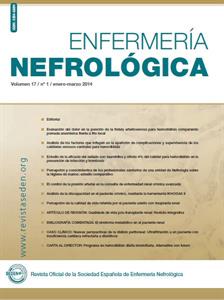Contenido del artículo principal
Resumen
El dolor en pacientes de hemodiálisis no es valorado en su totalidad y no se tiene en cuenta las limitaciones queprovoca en la calidad de vida de estos pacientes.
Se realizó un estudio observacional analítico, en el que se analizó el grado de dolor al que es sometido el paciente en hemodiálisis cuando se punciona su fístula arteriovenosa. Para ello comparamos el dolor que producía dicha punción si antes utilizábamos uno de estos tres métodos: POMADA ANÉSTESICA (Emla®), PLACEBO (crema hidratante) y HIELO. También
hemos evaluado si el método utilizado interfi ere en los parámetros de diálisis durante la sesión.
Estudiamos a 28 pacientes (23 hombres y 5 mujeres) portadores de fístula. Las variables medidas fueron: dolor (escala EVA), fl ujo sanguíneo, presión arterial, presión venosa y tiempo de coagulación. Estas variables fueron recogidas durante las tres semanas de duración del estudio (36 sesiones de hemodiálisis) en gráfi cas.
Se analizaron las 36 sesiones de hemodiálisis mediante el uso de una gráfi ca. Por un lado observamos que el
método elegido (Emla®) es estadísticamente signifi cativo (p-valor, p=0.004), por otro lado no existen diferencias
signifi cativas entre el método usado y el resto de parámetros recogidos durante la sesión de hemodiálisis
(p=0.194, p=0.278, p=0.902, p=0.445). Con respecto al método utilizado los pacientes eligieron como mejor
método la Emla® con un 67.86%.
Según los datos obtenidos podemos concluir que no existen diferencias estadísticas en las diferentes variables estudiadas. El uso de Emla® obtiene mejor resultado en cuanto al dolor, pero no varía ningún otro parámetro al igual que los otros dos métodos
Se realizó un estudio observacional analítico, en el que se analizó el grado de dolor al que es sometido el paciente en hemodiálisis cuando se punciona su fístula arteriovenosa. Para ello comparamos el dolor que producía dicha punción si antes utilizábamos uno de estos tres métodos: POMADA ANÉSTESICA (Emla®), PLACEBO (crema hidratante) y HIELO. También
hemos evaluado si el método utilizado interfi ere en los parámetros de diálisis durante la sesión.
Estudiamos a 28 pacientes (23 hombres y 5 mujeres) portadores de fístula. Las variables medidas fueron: dolor (escala EVA), fl ujo sanguíneo, presión arterial, presión venosa y tiempo de coagulación. Estas variables fueron recogidas durante las tres semanas de duración del estudio (36 sesiones de hemodiálisis) en gráfi cas.
Se analizaron las 36 sesiones de hemodiálisis mediante el uso de una gráfi ca. Por un lado observamos que el
método elegido (Emla®) es estadísticamente signifi cativo (p-valor, p=0.004), por otro lado no existen diferencias
signifi cativas entre el método usado y el resto de parámetros recogidos durante la sesión de hemodiálisis
(p=0.194, p=0.278, p=0.902, p=0.445). Con respecto al método utilizado los pacientes eligieron como mejor
método la Emla® con un 67.86%.
Según los datos obtenidos podemos concluir que no existen diferencias estadísticas en las diferentes variables estudiadas. El uso de Emla® obtiene mejor resultado en cuanto al dolor, pero no varía ningún otro parámetro al igual que los otros dos métodos
Palabras clave
DOLOR
PUNCIÓN FÍSTULA ARTERIOVENOSA
EMLA
DIÁLISIS
Detalles del artículo
Licencia
Aviso de derechos de autor/a
© Los autores ceden de forma no exclusiva los derechos de explotación de los trabajos publicados y consiente en que su uso y distribución se realice con la Licencia Creative Commons Atribución - No comercial 4.0 Internacional (CC BY-NC 4.0). Puede consultar desde aquí la versión informativa y el texto legal de la licencia. Esta circunstancia ha de hacerse constar expresamente de esta forma cuando sea necesario.
Cómo citar
1.
Ahís Tomás P, Peris Ambou IC, Pérez Baylach CM, Castelló Benavent J, Novas A. Evaluación del dolor en la punción de la fístula arteriovenosa para hemodiálisis comparando pomada anestésica frente a frío local. Enferm Nefrol [Internet]. 2014 [consultado 13 Nov 2025];17(1):[aprox. 5 p.]. Disponible en: https://www.enfermerianefrologica.com/revista/article/view/4226




